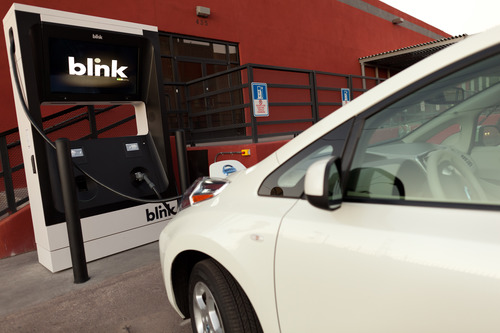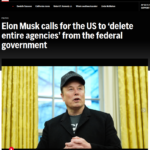There are big dreams and goals for electric car adoption in California, around the U.S. and around the world. California’s goals are something like 1 million plug-in EV’s by 2025 which seems to me to be achievable, unless this dalliance with fuel cell vehicles causes the state to undermine battery EV’s, or unless the falling price for gasoline causes a big exodus away from electric vehicles. Hopefully neither of those EV’s-will-fail fears will pan out, and electric vehicle adoption will continue growing purely on their own merits – fuel cost savings, lower environmental footprint, and a host of other benefits. The question then is – what should the electric vehicle recharging infrastructure look like?
Going by a conference call held today, sponsored by the Antelope Valley Clean Cities![]() group, it might unfortunately be focused on workplace charging and home-based charging, with short shrift given to public charging.
group, it might unfortunately be focused on workplace charging and home-based charging, with short shrift given to public charging.
 |
| EV Charging Infrastructure Priorities Source: Mark Duvall, EPRI |
The conference call gave several presenters the chance to discuss the challenges in electric vehicle charging infrastructure. Each talked of how two areas are the top priority :- Workplace Charging, and charging for Multi-Unit-Dwelling residents. And of those two it was Workplace Charging deployment that garnered the bulk of the attention.
In my mind these priorities are screwed up. Yes those two areas are important, but so too is public charging.
I imagine their reasoning hits on these points:
- Single family home dwellers can easily get a charging station at home. Therefore those people don’t need any government help other than streamlining permitting procedures, and maybe a tax break.
- Employers need serious convincing to offer charging stations to employees.
- Multi-Unit-Dwelling residents have a huge barrier to charging at home – reluctant landlords.
- The current crop of electric cars are just city cars with paltry 100ish mile ranges, so therefore nobody in their right mind will take one on a long trip, and therefore public charging isn’t all that interesting.
I also want to do another thing with my electric car – take long trips. I don’t care about the 100ish mile range, I still want to take longer trips, and to do so purely on electricity. Why should those Model S owners have all the fun?
With that in mind, consider the above pair of maps. To the left is the current infrastructure as of some time in 2013. The current infrastructure as of late 2014 is a little better than that, fortunately, but there are still huge gaps. Also, note those green dots up in Oregon? That’s the southern-most end of the West Coast Electric Highway which is a string of FAST CHARGING stations along highways in Oregon and Washington. Originally the WCEH was going to cover the WHOLE WEST COAST but California wimped out and didn’t fulfill their end of the bargain.
On the right is obviously an idealized what-would-be-perfect map of charging infrastructure. I’ve spent time browsing PlugShare looking at places to drive to and certainly hoping there would be as many DC Fast Charging stations on the map as are shown here.
I want to go to Mt. Shasta or Yosemite or to Arcata or a number of other wonderfully remote places in California, but to do so on Electricity. I’ve heard that Medicine Lake (East of Mt. Shasta) is a wonderful place, and I want to experience it. How would I get there?
Right now it’s easy to get to the Davis/Sacramento area on fast charging, and reach Redding on level 2 charging. But beyond that you have mountains and very few official charging stations. Reaching Arcata is even more difficult because there’s a long stretch of extremely underpopulated territory with very few resources of any kind. Yosemite is a little easier, with Fast Charging stations able to get a driver to the base of the Sierra Nevada mountains, and then several level 2 charging stations on the way to Yosemite National Park.
What we need is implementation of those red dots shown on the right-hand map. Our friends in Washington and Oregon can (and do) go nearly anywhere because of the extensive Fast Charging infrastructure on the WCEH.
But let’s return to the conference call. As I said it focused on encouraging charging infrastructure at Workplaces and Multi-Unit-Dwellings.
The California Energy Commission is putting limited funds into charging station infrastructure deployment. The next solicitation is in Q1 2015, and the focus is on – you guessed it – Workplaces and Multi-Unit-Dwellings.
Therefore the CEC funding won’t help build out more public fast charging infrastructure.
One might get the impression that I’m negative on workplace and multi-unit-dwelling charging infrastructure. But that’s not true, both of those are necessary. I’d love to have even just a 120 volt outlet here at my apartment, and if I had a workplace access to charging at the office would make up for some of the inconvenience of no charging at home.
What I’m talking about is the absolute necessity of public fast charging.
Those guys at Tesla Motors are demonstrating the necessity in spades.
- Highway design could decrease death and injury risk, if “we” chose smarter designs - March 28, 2015
- GM really did trademark “range anxiety”, only later to abandon that mark - March 25, 2015
- US Government releases new regulations on hydraulic fracturing, that some call “toothless” - March 20, 2015
- Tesla Motors magic pill to solve range anxiety doesn’t quite instill range confidence - March 19, 2015
- Update on Galena IL oil train – 21 cars involved, which were the supposedly safer CP1232 design - March 7, 2015
- Another oil bomb train – why are they shipping crude oil by train? – Symptoms of fossil fuel addiction - March 6, 2015
- Chevron relinquishes fracking in Romania, as part of broader pull-out from Eastern European fracking operations - February 22, 2015
- Answer anti- electric car articles with truth and pride – truth outshines all distortions - February 19, 2015
- Apple taking big risk on developing a car? Please, Apple, don’t go there! - February 16, 2015
- Toyota, Nissan, Honda working on Japanese fuel cell infrastructure for Japanese government - February 12, 2015



















Pingback: Solar carports at apartment complexes to allow EV charging at multi-unit-dwellings | The Long Tail Pipe